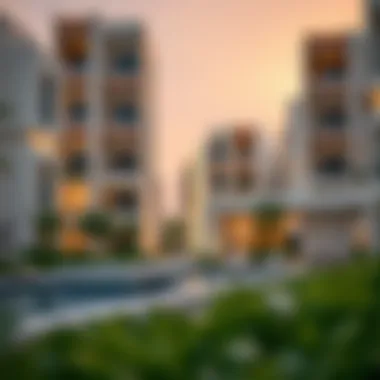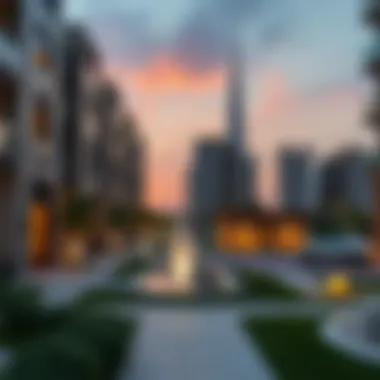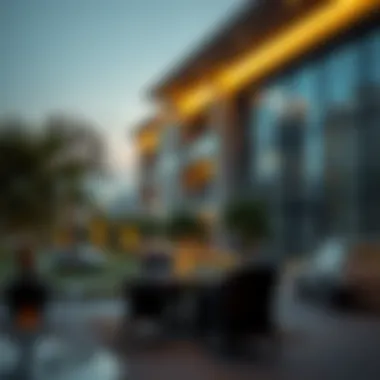Examining the Zayed Housing Program: Impacts and Insights


Intro
The Zayed Housing Program stands as a significant initiative shaping Dubai's housing environment. This program is aimed at providing affordable housing solutions to Emirati families and addressing the pressing demand for residential options in the ever-growing urban area. As real estate dynamics constantly shift, understanding the multifaceted aspects of this program can offer valuable insights, not just to residents but also to investors and developers navigating the local market landscape.
Given Dubai's reputation as a vibrant hub for expatriates and locals alike, the housing landscape can be a bit of a maze. The Zayed Housing Program aims to simplify this for Emiratis, providing them with the means to secure a home. It’s important to examine the broader picture, uncovering the objectives driving the program, the challenges it meets, and the impact it has on shaping the housing market.
By delving into the specifics of market trends and property investment strategies under this program, we can equip our readers with the knowledge they need to make informed choices. This will ultimately enhance their understanding of how the program influences both the real estate market and the housing choices available in Dubai.
Market Trends and Analysis
Recognizing the current conditions in Dubai’s real estate market is vital for grasping the effect of the Zayed Housing Program.
Current Market Conditions
The real estate sector in Dubai is experiencing noteworthy fluctuations. Prices in certain areas have surged, while others have begun to stabilize or decrease. The Zayed Housing Program’s efforts to provide affordable housing are more crucial now than ever. With property prices often reaching dizzying heights, the program lays down a much-needed pathway for Emirati families looking for reasonable housing options.
Furthermore, government policies and incentives, alongside foreign investments, continue to play a significant role in shaping the market. Consequently, areas that are part of the housing program have become focal points for development, potentially driving up property values.
- Key Factors Influencing the Market:
- Policy changes surrounding foreign investment.
- Shifts in demographic trends, with an influx of expatriates.
- Changing economic conditions due to global trends.
Future Predictions and Growth Areas
Looking ahead, the Zayed Housing Program is poised to capitalize on several growth areas within Dubai’s real estate market. Firstly, as development expands into the outskirts of the city, new communities might emerge. These areas may provide more affordable options that align with the program's objectives.
Investors are increasingly interested in mixed-use developments which combine residential and commercial spaces. The demand for such properties offers opportunities for growth while fulfilling the needs of a diverse population.
Understanding these growth hotspots can give investors leverage in decision-making.
Property Investment Strategies
For those considering investment within the framework of the Zayed Housing Program, evaluating the right strategies is essential.
Types of Properties to Consider
Investors should focus on various property types that may meet Zayed Housing Program criteria:
- Standalone Villas: These tend to be popular among families seeking more space.
- Townhouses: Offering a blend of privacy and community living.
- Apartments: An attractive option for younger families or single professionals.
Each of these categories can appeal to different segments of the Emirati population. Understanding buyer preferences can significantly influence investment choices.
Financing Options and Considerations
When it comes to financing, several avenues are available under the Zayed Housing Program. Investors should consider:
- Government Grants: Depending on eligibility, grants may help cover the costs of property.
- Low-Interest Loans: Many banks offer special financing options tailored to support program participants.
- Partnerships: Collaborating with established developers can also present unique financing opportunities.
Understanding these financing options is essential for maximizing investment potential while ensuring alignment with program stipulations.
With a careful examination of the Zayed Housing Program, one can appreciate the intricate web of factors contributing to the housing market in Dubai. By unraveling these elements, both residents and investors can make enlightened decisions that can lead to long-term satisfaction.
Prologue to the Zayed Housing Program
The Zayed Housing Program represents a significant chapter in Dubai's housing narrative. Established with the intention of providing affordable and quality housing solutions, this program aims to meet the growing demand for residential spaces in a rapidly urbanizing environment. What makes this initiative so vital is not just its immediate effects on accommodation availability but also its broader influence on the socio-economic fabric of Dubai.
By focusing on both expatriates and long-term residents, the Zayed Housing Program addresses a critical gap in the real estate market. It recognizes that housing is not merely about roofs over heads; it's about supporting families, fostering communities, and nurturing economic stability.
Historical Context
To fully appreciate the Zayed Housing Program, one must delve into its origins. Launched in the early 1990s, this initiative was a response to the demographic shifts and the increasing influx of residents from different backgrounds. The UAE's ambitious development goals called for a robust housing strategy to accommodate its growing population. As the city’s skyline expanded, so did the need for structured housing solutions. The government implemented the program as a means to ensure that all residents, irrespective of their financial capabilities, have access to decent homes. Over the years, several updates and reforms have enhanced its structure, allowing it to adapt to changing economic conditions and real estate trends.
Program Objectives


The core objectives of the Zayed Housing Program hinge on a few fundamental principles. It is designed to:
- Increase availability of affordable housing: The primary aim is to create numerous housing units that cater to various budget brackets, especially for those who struggle in the competitive real estate market.
- Promote homeownership: The program strongly emphasizes empowering residents to own their homes, thereby aiming to improve their financial security and investment in the community.
- Enhance community living: By constructing neighborhoods rather than individual units, the program seeks to bolster social cohesion and foster a sense of belonging among residents.
- Boost economic development: Through investments in housing, the program also indirectly stimulates local economies, creating jobs and potential for business growth in construction and related sectors.
As we unpack the layers of this initiative, the intertwining of its objectives with the actual needs of communities becomes increasingly apparent. Ultimately, this is not just a housing scheme; it is a foundational element of a thriving metropolis.
Structure of the Program
The structure of the Zayed Housing Program is pivotal in understanding its reach and effectiveness within the Dubai housing landscape. It encompasses the foundational elements that influence how the program operates, lays down the eligibility framework, and determines the accessibility for potential beneficiaries. By breaking down the key components—funding and resource allocation, eligibility criteria, and the application process—we can glean insights into how well designed the program is for meeting its objectives.
Funding and Resource Allocation
When we talk about funding, we refer not just to the numbers but also to the very lifeblood of the Zayed Housing Program. Proper funding ensures that housing units meet the standards that residents expect. The government allocates resources towards various channels, such as construction costs, land acquisition, and services infrastructure.
Here's what to keep in mind regarding funding and resource allocation:
- Source of Funding: The bulk of the financing comes from state budgets, but there are also private sector contributions and international investments.
- Impact on Quality of Construction: Adequate funding directly correlates to the quality of housing. When financing is squeezed, corners get cut, which can lead to dissatisfaction among residents.
- Long-Term Sustainability: This aspect is crucial in assessing the viability of housing investments. Ongoing funding promises that maintenance and upgrades can be scheduled, meaning homes can age well, rather than falling into disrepair over time.
Proper funding allocation is essential for sustaining quality housing, which in turn enhances living standards and community well-being.
Eligibility Criteria
Understanding the eligibility criteria is like cracking the code to access affordable housing under this program. The program aims to benefit a specific demographic, including low-to-middle-income families, which is crucial in shaping the landscape of community development in Dubai. Here are some points that illustrate its significance:
- Income Guidelines: There are clearly defined income caps that determine eligibility. Families earning below a specific threshold can apply, and this is adjusted periodically based on economic factors.
- Residency Requirements: Applicants must show proof of residency in Dubai, emphasizing the program’s focus on supporting local families.
- Age Restrictions: Applicants usually need to be above a certain age—typically 21—to ensure that they’re at a stage in life where homeownership makes sense.
By keeping the criteria straightforward yet mindful of the demographic, the program is designed to be inclusive without losing sight of its primary purpose—enhancing homeownership for those who need it most.
Application Process
Navigating the application process can be daunting for many, but the structure of the Zayed Housing Program aims to streamline it as much as possible. Here’s an overview of how the application process unfolds:
- Initial Inquiry: Potential applicants might begin with an informal inquiry, either through local government offices or online platforms, gaining a basic understanding of their eligibility.
- Document Preparation: This includes gathering necessary documents such as proof of income, residency details, and identification. Having the right documents ready can speed up the process significantly.
- Submission: Applications are usually submitted electronically to ensure that the government can handle them efficiently. In person options may also be available.
- Assessment: Once submitted, applications undergo a thorough review process, where each one's financial situation and eligibility are evaluated.
- Approval and Notification: Successful applicants receive a notification, typically detailing the next steps towards securing their housing.
The entire process is important because it establishes transparency and promotes trust among applicants. When people see a clear path to homeownership, it can foster a sense of community and belonging right from the start.
In summary, while dissecting the structure of the Zayed Housing Program, it becomes clear that funding, eligibility, and application processes are interwoven threads that, when stitched together effectively, offer a robust safety net for those seeking a place to call home in Dubai.
Impact on Housing Accessibility
The importance of housing accessibility cannot be understated, especially in a burgeoning metropolis like Dubai. With its rapid development and ongoing influx of expatriates and investors, the demand for affordable, quality housing is at an all-time high. The Zayed Housing Program plays a crucial role in this landscape by attempting to bridge the gap between market demands and resident needs. The effectiveness of this program hinges on several factors: affordability, ownership rates, and regional development, which we shall delve into.
Affordability of Housing
When discussing housing accessibility, affordability stands as a pillar. For most people, the cost of a home is the first consideration when entering the real estate market. The Zayed Housing Program has made strides in addressing this challenge. By providing subsidies and low-interest loans, it caters primarily to lower and middle-income families residing in Dubai.
One notable aspect is the push for balanced pricing. This means that homes are not just priced for the well-heeled among us, but for the everyday person too. With many housing options, ranging from modest apartments to single-family homes, the program enhances opportunities for a wider audience. This not only fosters a sense of belonging but also allows for financial growth in a sometimes volatile market.
"A roof over one's head is more than just a basic need; it's the foundation of a person's life."
Increase in Homeownership Rates
Homeownership is often perceived as a cornerstone of stability. For many Emiratis and expats alike, owning a piece of Dubai's landscape is a lifetime goal. The Zayed Housing Program has contributed significantly to the increase in homeownership rates, achieving a landmark status in this respect.
Through tailored initiatives, the program has chipped away at the barriers to homeownership. Many programs focus on facilitating access to properties for first-time buyers. With supportive measures such as favorable loan terms and financial assistance, the number of people who can claim ownership of their homes has markedly risen. This doesn’t just provide a sense of stability and satisfaction for individuals but also contributes positively to the community at large.
Regional Development
Housing accessibility is not merely about securing a home; it encompasses how these homes contribute to the surrounding environment. The Zayed Housing Program includes strategic planning that encourages regional development. This initiative pushes beyond just erecting buildings. It's about building communities.
Consider the interconnectedness of housing with public facilities like schools, parks, and hospitals. Properly planned residential areas can stimulate local economies, create job opportunities, and promote social cohesion. Investing in regional development ensures that the benefits of the housing program resonate beyond mere shelter. It’s a catalyst for overall growth.
Challenges Faced by the Program


When it comes to the Zayed Housing Program, several challenges have emerged that can impact its effectiveness and accessibility. Identifying these hurdles is crucial not just for understanding how the program operates but also for recognizing ways to strengthen housing initiatives in Dubai. Navigating the intricate landscape of real estate, especially within a rapidly growing metropolis, requires constant awareness and adaptability. Here, we’ll dive into three specific challenges faced by the program: bureaucratic hurdles, quality of housing units, and economic fluctuations.
Bureaucratic Hurdles
One of the most pressing challenges the Zayed Housing Program encounters is bureaucratic hurdles. The housing sector is often riddled with red tape, and this situation can lead to delays, frustration, and sometimes even project cancellations. For potential beneficiaries, the process of securing housing assistance can feel like climbing a steep mountain, where each step requires considerable effort and time.
Often, applicants must navigate a tangle of paperwork, approvals, and compliance checks. For the expatriate community, which comprises a significant portion of Dubai's population, this complexity can be especially daunting. Many may not be fully familiar with local regulations or the intricacies of government processes, thus hindering their ability to take advantage of the program.
This bureaucratic delay not only frustrates applicants but can also result in reduced overall trust in the program's efficacy, leading to disengagement from potential beneficiaries. It highlights the need for streamlined processes, possibly aided by modern technology to enhance efficiency and transparency.
Quality of Housing Units
Next up, we have the quality of housing units. While the Zayed Housing Program's intent is to provide affordable solutions, there have been instances where the standard of the housing constructed falls short of expectations. This discrepancy raises a crucial question about the long-term durability and safety of the properties offered under the program.
There are numerous anecdotal evidences where recipients have reported issues such as subpar construction materials or poor design that does not accommodate the needs of families living in these units. This can lead to ongoing maintenance problems and a sense of dissatisfaction among residents. When residents feel that they have compromised on quality, it can affect their overall perception of homeownership as a long-term investment.
To tackle this, there needs to be a more rigorous oversight mechanism ensuring that standards are upheld in each project. Accountability must be at the forefront, ensuring that housing units not only look good but stand the test of time.
Economic Fluctuations
Finally, economic fluctuations pose a significant challenge to the stability of the Zayed Housing Program. The real estate market in Dubai is known for its volatility, influenced by global economic trends, regional stability, and external economic pressure. When the economy suffers, so does the housing market, leading to fluctuations in housing prices, demand for units, and even potential layoffs within the sector.
For existing homeowners, economic downturns can lead to a drop in property values, making it hard to maintain their homes or resell them. Conversely, when the market booms, it can push prices beyond the reach of average families, rendering the core goal of the Zayed Housing Program moot.
Economic stability is intertwined with housing affordability; a fluctuation in the economy can have ripple effects on homeownership rates.
Overall, the sustainability and effectiveness of the Zayed Housing Program are profoundly affected by these challenges. Addressing bureaucratic obstacles, ensuring high-quality construction, and managing economic fluctuations are vital for improving the housing landscape in Dubai and enhancing the experience of its residents.
Community Impact
Understanding the community impact of the Zayed Housing Program is crucial in evaluating its true effectiveness. This program not only addresses the physical aspects of housing but also considers how it shapes the lives of residents. By enhancing community cohesion and facilitating social integration, the Zayed Housing Program significantly influences the overall quality of life for its beneficiaries. Furthermore, its focus on local infrastructure development and investment in public services creates a ripple effect that benefits not just the homeowners but the broader community as well.
Social Integration
The importance of social integration in the Zayed Housing Program cannot be overstated. Housing is not just about brick and mortar; it fosters relationships and builds networks. The program encourages neighborhoods where diverse groups can come together and thrive. Whether it’s through shared spaces or community events, new homeowners find themselves in an environment that promotes interaction. This integration is key to developing a sense of belonging, critical for both expatriates and locals in a multicultural city like Dubai.
Imagine a community where families from various backgrounds share playgrounds, schools, and even cafes. This fosters not just friendships but understanding and tolerance. As people engage with one another, social barriers begin to erode, paving the way for a united community. The Zayed Housing Program acts as a catalyst for this social harmony, showing how effective housing solutions can contribute to greater societal wellbeing.
Local Infrastructure Development
Housing development goes hand in hand with local infrastructure. The Zayed Housing Program recognizes this and has generated significant advancements in infrastructure that support not only residents but the commercial and public sectors as well.
- Transportation: Improved roads and public transit options make commuting easier for residents. This directly enhances accessibility to workplaces and education centers.
- Utilities: Upgraded water supply, electricity, and internet services ensure that homes are not just livable but offer modern amenities.
- Public Spaces: Parks, community centers, and recreational facilities enrich the neighborhood, fulfilling the everyday needs of families and individuals.
The result is a neighborhood where convenience thrives, and quality of life rises. When a program invests in infrastructure, it builds the foundation for a sustainable community that can grow and adapt over time.
Investment in Public Services
The investment in public services is an integral part of the Zayed Housing Program's framework. Beyond constructing houses, it emphasizes the need for services that can elevate living standards. Education, healthcare, and social services all play pivotal roles.
- Education: The program supports schools and educational facilities, making quality education accessible to all.
- Healthcare: By establishing clinics and health centers, it ensures that medical services are readily available, offering peace of mind to families.
- Community Services: Efforts to enhance local governance and community engagement promote collective responsibility and allow residents to have a voice in decisions affecting their lives.
"A well-rounded community is one that nurtures its members, providing not just housing but also the essential services that allow them to thrive." This approach highlights that when public services improve, they contribute to individual wellbeing and community resilience.
In summary, the community impact of the Zayed Housing Program is a multifaceted topic that extends beyond mere housing statistics. Its effect on social integration, local infrastructure, and public services shapes the dynamic landscape of Dubai, making it a key area for stakeholders in real estate and urban development to consider.
Future Prospects of the Zayed Housing Program
As the Zayed Housing Program continues to evolve, its future prospects hold a significant impact on Dubai’s housing market. This section examines key areas including government initiatives pushing the program forward, sustainability goals that align with global standards, and predicted market trends influenced by the program’s developments. Each of these aspects not only shapes the outlook for housing in Dubai but also reflects broader socio-economic changes that directly affect residents’ quality of life.
Government Initiatives
Various government initiatives are underway to strengthen and refine the Zayed Housing Program, particularly as it aims for better accessibility and affordability. Authorities are focusing on creating policies that not only support housing but also enhance the overall infrastructure in the emirate. This is about more than just building houses; it’s about developing vibrant communities where people can thrive.


For instance, the government has been promoting partnerships with private developers. Such collaborations can lead to innovative housing solutions that incorporate new technologies and design principles, maximizing both energy efficiency and aesthetic appeal. In addition, initiatives like shared ownership schemes and potential subsidies for lower-income families are coming into play, aiming to create a more inclusive housing market. These efforts demonstrate the government's commitment to meeting the housing needs of diverse demographics, especially with Dubai's growing expatriate population.
Sustainability Goals
Sustainability is no longer an option; it's a necessity. The Zayed Housing Program is increasingly aligned with environmental sustainability goals. The program has begun integrating green building practices that enhance energy efficiency and reduce carbon footprints. These practices are not just buzzwords; they position the program in line with international standards while addressing local needs.
Some of the specific sustainability measures include:
- Implementing energy-efficient appliances in new homes
- Utilizing sustainable materials in construction
- Encouraging residents to adopt green lifestyles through community programs
By infusing sustainable elements into housing construction and management, the program acknowledges its responsibility towards future generations. These goals are crucial in a region that faces challenges such as water scarcity and extreme heat.
Predicted Market Trends
Looking ahead, the evolution of the Zayed Housing Program is likely to influence several market trends in the real estate sector. Experts forecast an increase in demand for affordable housing, driven by a combination of factors including demographic growth and a shift in consumer preferences towards more sustainable living options.
- Increased demand for smart homes: With technological advancements, potential homeowners are on the lookout for properties that integrate smart home features. This trend not only enhances convenience but also supports energy conservation.
- Shift towards community-driven development: As people seek a sense of belonging, there is likely to be a greater interest in neighborhood design that fosters social integration and communal spaces.
- Potential fluctuations in property prices: While the government’s initiatives may stabilize prices, factors such as global economic conditions and local demand could create unpredictable movements in pricing dynamics.
"Sustainable, affordable, and community-oriented housing will be critical for Dubai's future."
In sum, the future prospects of the Zayed Housing Program are buoyed by strong government backing, a commitment to sustainability, and evolving market trends. As these facets interplay, they will significantly shape the landscape of Dubai’s housing market, making it not only more accessible but also more enjoyable to live in.
End
The Zayed Housing Program represents a significant endeavor in shaping the housing landscape of Dubai. This conclusion is not merely an end but a synthesis of insights gleaned from its multifaceted operations, and it stands out as a beacon for future housing initiatives. The importance of concluding this analysis lies in recognizing the overarching elements that have emerged throughout the discussion.
Recap of Main Points
In our exploration of the Zayed Housing Program, we noted several key takeaways:
- The historical context and objectives underline the government’s commitment to improving housing accessibility.
- The structured framework provided clarity on how funding and resources are allocated within the program.
- Challenges, particularly bureaucratic hurdles and quality issues, cannot be overlooked as they play a crucial role in impacting residents’ experiences.
- The positive outcomes, such as increased homeownership rates, speak volumes of its impact on the community, while the socio-economic factors shape its efficacy.
- Future prospects, including sustainability goals, suggest a roadmap for evolving to meet contemporary needs.
This comprehensive recap reinforces that while the Zayed Housing Program has paved the way for enhanced living standards, ongoing attention to its challenges is paramount.
Final Thoughts on Housing in Dubai
As we gaze towards the horizon of Dubai's ever-evolving real estate sector, the significance of the Zayed Housing Program cannot be understated. This initiative does not work in isolation; it intertwines with a larger narrative of growth where housing reflects cultural shifts and economic conditions. The program’s focus on providing affordable and quality housing is crucial, especially for expatriates and local citizens looking for stability in an often volatile market.
Looking forward, one must consider how effective policy adjustments and community engagement can further enhance the outcomes of such programs. Investors and developers should actively participate in this dialogue, as their insights could catalyze improvements that benefit everyone involved. The challenge remains: to balance growth with inclusivity—to ensure that the housing dreams of a diverse populace do not go unfulfilled.
Housing in Dubai is not simply a matter of walls and roofs; it is about nurturing communities and fostering a sense of belonging. In this light, the Zayed Housing Program stands as an instrument for change, illuminating a path forward in an age where housing equity is ever more vital.
Building homes isn't just constructing buildings; it's about nurturing communities and ensuring everyone feels they belong.
As we close on this examination, it is evident that the Zayed Housing Program serves as a reflection of Dubai's aspirations, a commitment to addressing the housing needs of its dynamic population, and a crucial factor in the city's broader development narrative.
For further insights on housing trends and policy initiatives, consider exploring resources on government housing strategies at *.gov and academic perspectives at *.edu.
Appendices and Resources
Understanding the Zayed Housing Program requires digging into a wealth of information—this is where appendices and resources come into play. These sections are not just convenience; they are essential to the overall comprehension of the program’s structure, effectiveness, and future outlook. By incorporating varied resources, one can gain a more profound understanding of how the program operates within the real estate landscape of Dubai.
Reference Materials
Reference materials serve as a backbone for any examination of a program as impactful as the Zayed Housing Program. They provide documentation, analysis, and statistical data essential for illustrating various aspects of the program and its implications for diverse stakeholders. Here’s what constitutes key reference materials:
- Government Reports: Often, the most accurate data comes from official reports by the Ministry of Housing and Urban Planning, offering insights into allocations and statistics.
- Academic Articles: Research papers from universities and think tanks can shed light on the socio-economic impacts of the program, backed by empirical evidence.
- Market Analysis: Reports by real estate consultancy firms frequently analyze trends influenced by the program, with predictive insights for potential investors.
"Well-informed stakeholders can make better decisions based on reliable data, shaping their strategies to align with market realities."
The use of these materials ensures that anyone examining the program has a well-rounded perspective. Whether it’s potential investors, developers, or expats looking for housing, the availability of accurate references is crucial.
Contact Information for Further Inquiries
For those with lingering questions or who seek personalized guidance regarding the Zayed Housing Program, knowing where to turn is vital. Numerous, credible channels exist:
- Ministry of Housing: Direct inquiries can often yield the most current and relevant information. Their website offers contact forms and detailed phone numbers for specific departments. Visit: moh.gov.ae
- Real Estate Agencies: Many local agencies specialize in accommodations within this framework. Firms like Allsopp & Allsopp or Betterhomes provide tailored guidance based on the latest market trends.
- Expat Forums: Platforms such as reddit.com have vibrant communities where expats share experiences and practical advice regarding housing in Dubai.
Reaching out to these resources guarantees up-to-date information and firsthand accounts, further enriching one’s understanding of how the Zayed Housing Program affects housing options in Dubai.
By creating an environment where easily accessible information is available, potential residents can engage meaningfully with the realities of the housing market in Dubai.











